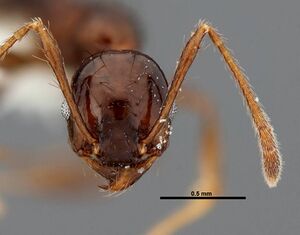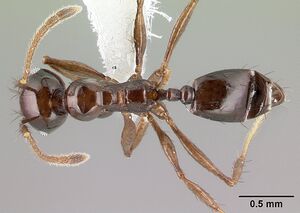Pheidole leoncortesi
| Pheidole leoncortesi | |
|---|---|

| |
| Scientific classification | |
| Kingdom: | Animalia |
| Phylum: | Arthropoda |
| Class: | Insecta |
| Order: | Hymenoptera |
| Family: | Formicidae |
| Subfamily: | Myrmicinae |
| Tribe: | Attini |
| Genus: | Pheidole |
| Species: | P. leoncortesi |
| Binomial name | |
| Pheidole leoncortesi Longino, 2009 | |
This species occurs in wet forest habitat. It is locally abundant and recruits heavily to baits on the forest floor. Major and minor workers frequently occur together at baits. The nest is unknown. (Longino 2009)
Identification
With the general habitus and morphometric profile of Pheidole tschinkeli, with which it is sympatric. Minor and major worker: katepisternum and side of propodeum uniformly foveolate versus with conspicuous rugulae overlaying foveolate sculpture; propodeal spines short, tapering, with sharp tips, versus long, not tapering, tips blunt. (Longino 2009)
Distribution
Chiapas
Latitudinal Distribution Pattern
Latitudinal Range: 18.64° to 17.1250952°.
| North Temperate |
North Subtropical |
Tropical | South Subtropical |
South Temperate |
- Source: AntMaps
Distribution based on Regional Taxon Lists
Neotropical Region: Mexico (type locality).
Distribution based on AntMaps
Distribution based on AntWeb specimens
Check data from AntWeb
Countries Occupied
| Number of countries occupied by this species based on AntWiki Regional Taxon Lists. In general, fewer countries occupied indicates a narrower range, while more countries indicates a more widespread species. |

|
Estimated Abundance
| Relative abundance based on number of AntMaps records per species (this species within the purple bar). Fewer records (to the left) indicates a less abundant/encountered species while more records (to the right) indicates more abundant/encountered species. |

|
Biology
Castes
Worker
Minor
Images from AntWeb
   
| |
| Paratype Pheidole leoncortesi. Worker. Specimen code casent0609112. Photographer Stephanie Ware, uploaded by Field Museum. | Owned by FMNH. |
   
| |
| Paratype Pheidole leoncortesi. Worker. Specimen code casent0609115. Photographer Erin Prado, uploaded by California Academy of Sciences. | Owned by CAS. |
Major
Images from AntWeb
   
| |
| Paratype Pheidole leoncortesi. Worker (major/soldier). Specimen code casent0609134. Photographer Erin Prado, uploaded by California Academy of Sciences. | Owned by CAS. |
 
| |
| Worker (major/soldier). Specimen code casent0609140. Photographer J. Longino, uploaded by University of Utah. | Owned by JTLC. |
Nomenclature
The following information is derived from Barry Bolton's Online Catalogue of the Ants of the World.
- leoncortesi. Pheidole leoncortesi Longino, 2009: 49, fig. 13 (s.w.) MEXICO.
Unless otherwise noted the text for the remainder of this section is reported from the publication that includes the original description.
Description
Worker
Minor Measurements (paratype): HL 0.72, HW 0.65, HLA 0.28, SL 0.78, EL 0.16, ML 0.94, PSL 0.07, PMG 0.03, SPL 0.03, PTW 0.13, PPW 0.20, CI 90, SI 120, PSLI 10, PMGI 3, SPLI 4, PPI 154.
Measurements (n=10): HL 0.67-0.78, HW 0.59-0.68, SL 0.73-0.86, CI 87-91, SI 120-127.
Mandible, clypeus, and entire face smooth and shiny, highly polished; margin of vertex rounded with median impression; occipital carina narrow, barely visible in full face view; scape with abundant erect setae longer than maximum width of scape; promesonotal groove present, strongly impressed; propodeal spines present, with sharp tips; katepisternum and side of propodeum foveolate, rest of mesosoma smooth and shining; mesosomal dorsum with about six pairs erect black setae; dorsal (outer) margin of hind tibia with appressed pubescence and 4-6 suberect setae that are longer than maximum width of tibia; first gastral tergum smooth and shining; gastral dorsum with moderately abundant, erect stiff black setae; color dark red brown.
Major Measurements (holotype): HL 1.13, HW 1.08, HLA 0.32, SL 0.79, EL 0.19, ML 1.07, PSL 0.10, PMG 0.05, SPL 0.05, PTW 0.21, PPW 0.32, IHT 0.43, OHT 0.49, CI 96, SI 73, PSLI 9, PMGI 4, SPLI 4, PPI 154, HTI 87.
Measurements (n=10): HL 1.09-1.21, HW 1.07-1.18, SL 0.76-0.84, CI 94-98, SI 67-74.
Mandible smooth and shiny; clypeus smooth and flat with distinct anterior notch; face mostly smooth and shiny, with a few carinulae on malar space; head lacking setae projecting from sides of head in face view; scape smooth and shining, terete at base, with appressed pubescence and abundant erect setae longer than maximum width of scape; hypostomal margin flat; median tooth absent or a small gibbosity; inner hypostomal teeth thin and sharp, located much closer to outer hypostomal teeth than to midline; promesonotal groove present; propodeal spines present; katepisternum and side of propodeum foveolate, rest of mesosoma smooth and shining; mesosomal dorsum with about six pairs erect black setae; dorsal (outer) margin of hind tibia with appressed pubescence and 4-8 suberect setae that are longer than maximum width of tibia; first gastral tergum smooth and shining; gastral dorsum with moderately abundant, erect stiff black setae; color dark red brown.
Type Material
Holotype major worker. Mexico, Chiapas: 21km SW Salto de Agua, 17.38542°N 92.42802°W, ±200m, 180m, 15 Jun 2008 (LLAMA#Ba-A-08-3-01-03) UNAM, unique specimen identifier CASENT0609109.
Paratypes: major and minor workers. Same data as holotype The Natural History Museum, California Academy of Sciences, EAPZ, ECOSCE, Field Museum of Natural History, Instituto Nacional de Biodiversidad, John T. Longino Collection, Los Angeles County Museum of Natural History, Museum of Comparative Zoology, Musee d'Histoire Naturelle Genève, Instituto de Zoologia Agricola, Museu de Zoologia da Universidade de Sao Paulo, University of California, Davis, UNAM, ICN, National Museum of Natural History.
Etymology
The species is named for Dr. Jorge León Cortés, Director of the San Cristobal campus of the Colegio de la Frontera Sur, Chiapas, Mexico. Jorge was an extremely generous and effective host during LLAMA project sampling in Chiapas. He is an energetic field biologist actively promoting biological studies in Chiapas.
References
- Longino, J.T. 2009. Additions to the taxonomy of New World Pheidole. Zootaxa 2181: 1-90. PDF
References based on Global Ant Biodiversity Informatics
- Ahuatzin D. A., E. J. Corro, A. Aguirre Jaimes, J. E. Valenzuela Gonzalez, R. Machado Feitosa, M. Cezar Ribeiro, J. Carlos Lopez Acosta, R. Coates, W. Dattilo. 2019. Forest cover drives leaf litter ant diversity in primary rainforest remnants within human-modified tropical landscapes. Biodiversity and Conservation 28(5): 1091-1107.
- Dattilo W. et al. 2019. MEXICO ANTS: incidence and abundance along the Nearctic-Neotropical interface. Ecology https://doi.org/10.1002/ecy.2944
- Vasquez-Bolanos M. 2011. Checklist of the ants (Hymenoptera: Formicidae) from Mexico. Dugesiana 18(1): 95-133.

